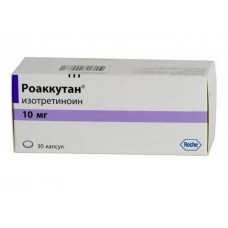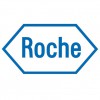Expiration date: 10/2027
Composition and form of release
Capsules: one capsule contains:
Isotretinoin (13-cis-retinoic acid) 10 mg, 20 mg,
excipients: soybean oil, yellow beeswax, hydrogenated soybean oil, partially hydrogenated soybean oil,
30 or 100 capsules per pack.
Pharmacological action:
Roaccutane - regeneration stimulator, retinoid for systemic acne therapy
Isotretinoin, the active substance of Roaccutane, is a stereoisomer of completely trans-retinoic acid (tretinoin).
It has a specific anti-seborrheic effect in severe forms of acne (acne), which are not amenable to other types of therapy. The mechanism of action of the drug is not fully elucidated, however, it has been established that the improvement of the clinical picture of the disease is associated with a dose-dependent decrease in the activity of the sebaceous glands and a decrease in their size, which is confirmed by histological studies. In addition, the anti-inflammatory effect of isotretinoin on the skin has been proven.
Indications
Severe forms of nodular-cystic acne,
acne that does not respond to previous therapy, in particular, cystic and conglobate acne, especially on the trunk.
Method of application
Treatment with Roaccutane should be carried out by specialist doctors with experience in the use of systemic retinoids.
The initial dose is 0.5 mg / kg per day. Often, at the beginning of treatment, there is a short-term exacerbation of acne. The effectiveness and side effects of isotretinoin vary in different patients, therefore, after about 4 weeks of therapy, it is necessary to carry out an individual correction of the maintenance dose in the range from 0.1 to 1.0 mg / kg per day.
Patients with very severe forms of the disease or with acne of the trunk may require higher daily doses - up to 2.0 mg / kg. It has been proven that the frequency of remission and prevention of relapses is optimal when using a cumulative dose of 120 mg / kg (per course of treatment). Usually the treatment lasts 16-24 weeks.
Evaluating its results, it should be remembered that often the improvement continues after the drug is discontinued. Therefore, before prescribing a repeat course, you should take a break of at least 8 weeks. The repeated course of treatment is carried out in accordance with the above recommendations.
Capsules are taken with meals, once or twice a day
In patients with severe renal insufficiency, treatment should begin with a lower dose (for example, 10 mg / day) and individually select it, depending on tolerability. .
Simultaneous external treatment
Simultaneous administration of other acne medications with keratolytic or exfoliative effects, as well as UFO therapy, are not indicated. Patients should avoid insolation. If necessary, you can prescribe mild external anti-acne medications.
Contraindications
Pregnancy, hepatic and renal insufficiency, hypervitaminosis A, severe hyperlipidemia and hypersensitivity to the drug.
Side effects
Most of the side effects of Roaccutane depend on the dose. As a rule, when prescribing the recommended doses, the benefit-risk ratio, taking into account the severity of the disease, is acceptable for the patient.
Symptoms associated with hypervitaminosis A: most often - dry skin, mucous membranes of the lips, nasal cavity (bleeding), larynx (hoarseness of voice), eyes (conjunctivitis, reversible corneal opacity and contact lens intolerance).
Skin and its appendages: rash, itching, facial dermatitis, sweating, pyogenic granuloma, paronychia, onychodystrophy, increased growth of granulation tissue, persistent thinning of hair, reversible hair loss, fulminant forms of acne, hirsutism, hyperpigmentation, photosensitization.
Musculoskeletal system: muscle pain, joint pain, hyperostosis and other bone changes, tendinitis. One patient described the development of spinal hyperostosis and calcification of vertebral ligaments with subsequent compression of the spinal cord during prolonged (for several years) treatment with another retinoid group drug - Tigasone (etretinate). Roaccutane is not intended for long-term use, however, it should be remembered about the likelihood of this side effect with improper (too long) use of the drug.
Central nervous system and mental sphere: behavioral disorders, depression, headache, increased intracranial pressure, seizures.
Sensory organs: individual cases of visual acuity impairment, decreased hearing acuity in a certain range of sound waves, photophobia, violation of dark adaptation (decreased acuity of twilight vision), cataracts, keratitis.
Gastrointestinal tract: nausea, inflammatory bowel diseases (colitis, ileitis), bleeding, transient and reversible increase in transaminase activity, isolated cases of hepatitis. In many of these cases, the changes did not go beyond the norm and returned to the baseline during treatment, but in some situations it was necessary to reduce the dose or cancel Roaccutane.
Respiratory organs: bronchospasm.
Blood system: decrease in the number of leukocytes and erythrocytes, increase or decrease in the number of platelets, acceleration of ESR.
Laboratory changes: hypertriglyceridemia, hypercholesterolemia, hyperuricemia, some cases of a decrease in the level of HDL, especially when prescribing the drug in a large dose to predisposed patients (with a family history, burdened by a violation of fat metabolism, diabetes mellitus, obesity or alcoholism). These changes are also dose-dependent and normalize after dose reduction or drug withdrawal.
Immune system: local or systemic infections caused by gram-positive pathogens (Staphylococcus aureus).
Other: lymphadenopathy, hematuria, proteinuria, pancreatitis (especially high risk in patients with hypertriglyceridemia > 800 mg), vasculitis (Wegener's granulomatosis).
Precautions
Roaccutane should be prescribed only by doctors, preferably dermatologists who have experience in the use of systemic retinoids and are aware of the risk of teratogenicity when using Roaccutane.
It is recommended to monitor liver function before treatment, 1 month after its start, and then every 3 months. It is also necessary to determine the level of lipids in the serum on an empty stomach (before treatment, 1 month after the start and at the end of a 3-4-month course of treatment).
In rare cases, depression, psychotic symptoms and suicidal attempts have been described in patients treated with Roaccutane. Although their causal relationship with the use of the drug has not been established, special care should be taken in patients with a history of depression and all patients should be monitored for depression during treatment with the drug, if necessary, referring them to the appropriate specialist.
Due to the possibility of bone changes, Roaccutane should be prescribed only for severe forms of the disease, carefully assessing the ratio of possible benefits and risks and limiting the use of the drug only to severe cases of the disease.
Since acne is an androgen-dependent disease, contraceptives containing progestin with androgenic action, for example, derivatives of 19-nortestosterone, should not be used, especially if the patient has gynecological endocrine pathology.
Dermoabrasion should be avoided in patients receiving Roaccutane, as well as for 5-6 months after the end of treatment due to the possibility of increased scarring in atypical places.
During treatment with Roaccutane and for 5-6 months after it, epilation with wax applications should not be carried out due to the risk of dermatitis.
Patients from the high-risk group (with diabetes, obesity, alcoholism or disorders of fat metabolism) may require more frequent laboratory monitoring of relevant indicators during treatment with Roaccutane.
In the presence of diabetes or suspicion of it, a more frequent determination of glycemia is recommended. There are reports of an increase in fasting blood glucose and cases of diabetes during treatment with Roaccutane, although their causal relationship with taking the drug has not been established.
In patients who receive or received Roaccutane shortly before (1-2 weeks), it is impossible to take donor blood for transfusion to women of childbearing age.
Patients should avoid sunlight and not receive UFO therapy.
Drug interactions
Due to the possible increase in the symptoms of hypervitaminosis A, simultaneous administration of Roaccutane and vitamin A should be avoided.
Since tetracyclines can also cause an increase in intracranial pressure, their use in combination with Roaccutane is contraindicated.
Isotretinoin can weaken the effectiveness of micropiles with progesterone, therefore, contraceptives containing small doses of progesterone should not be used.
Storage conditions
Store at a temperature not exceeding 25 ° C, in a place protected from light and moisture.
Keep out of reach of children
Shelf life: 3 years.



